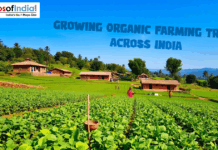“Food packaging is essentially packaging for food. It requires protection, tampering resistance, and special physical, chemical, or biological needs. It also shows the product that is labeled to show any nutrition information on the food being consumed.” Physical protection from shock, vibration etc. is necessary for the food product enclosed in the package. Other requirements include a ‘barrier’ to prevent the food product being contaminated by dust, water vapor etc. Desiccants are often used to prevent oxygen contamination. Such measures are usually adopted to keep the food contained in the package clean and fresh, and for an extended shelf life. Use of special or modified atmosphere inside the package is a common practice in packaged foods. Labels on the package are so designed that they cite clearly the usage, recycling and disposal of the food product or package. Such labels also serve the function of attracting potential buyers. ‘Tamper resistant’ and ‘tamper evident’ seals increase the security of shipping of packaged food products.
The Indian food industry has grown from strength to strength in the past few years. After China, India is the second largest food producer in the world with the potential of being the number one in the future. The recent surprising rise in the packaged and processed foods demands noted mainly in the metropolises, are due to a variety of reasons. The metropolis are the biggest consumer of packaged food. This can be attributed to the drastic change in the lifestyle of the consumers of packaged food in the metros. Prevalence of nuclear families, working parents, bachelors refusing to eat out in the, who are mostly engaged in time pressured jobs hardly have the time and expertise needed to cook a conventional meal, which has affected their food habits in a major way. Packaged food is a smart solution which saves both the time and rigors of cooking a conventional meal. Increasing health awareness amongst the consumers also makes packaged food a ready preference since packaged food contains ingredients such as herbs, vitamins, minerals, pro-biotic and other essential nutrients.
The main categories of packaged food are bakery, canned/dried and frozen processed food, meal substitute food products, dairy products, ready to eat frozen foods, processed meat etc. Some of the major industries of India involved in packaged food manufacturing are listed below:
• HISDUTAN UNILEVER: dealing mostly in instant beverages and biscuits, pulses etc.
• PEPSICO: mainly dealing with aerated drinks but also products like snacks and fruit juices.
• NESTLE: dealing with instant beverages, milk products and ready to eat foods.
• HALDIRAMS: dealing with sweets, sweet and sour snacks and syrups.
• RUCHI SOYA INDUSTRY: one of India’s largest food and FMCG based companies has launched a joint venture with TOYOTA TSHUSHO corporation to tap the growing packaged food industry in India
• MINIMELTS have gone into a joint venture with HONEYBEE ENTERTAINMENTS to access the Rs2500 crore organized ice-cream market in India.
• ITC invests to plan Rs1,000crores in the FMCG sector in India in the next couple of years
• COSTA COFFEE plans to set up 200 more outlets in India. The expected investment is Rs200crores
• CARGILL INDIA plans to expand its edible oil plants (expected investment Rs100crores) and an additional corn grinding and manufacturing mill in Karnataka involving an investment of Rs400crores
• TWININGS INDIA (UK based Associated British Foods), and a major tea company plans to introduce ‘Ovaltine’, a malted brand of health drink in India.
The most comprehensive report provided on the steep increase in the gradient of packaged food in India is provided by ASSOCHAM (Associated Chambers of Commerce and Industry of India) in an industry specific analysis, which states that, “Growing at a compound annual growth rate (CAGR),of about 15 to 20% annually, the Indian packaged food industry is likely to touch the $30 billion mark by 2015 from the current level of $15 billion including snacks food, ready-to-eat-foods, healthy and functional foods. Factors that have fuelled this industry’s growth are the arrival of the food multinationals, rising popularity of the of quick service restaurants, modern retail trade, technological advancements, changing urban lifestyle and so on.” Other salient features of the report include:
• The prediction that the Indian packaged food industry is in for a fast growth in the next 5 years.
• Estimated growth of the packaged food industry by 40% to 60%in the next five years
• In major metropolitan cities like Mumbai, Kolkata, Chennai, Bangaluru, Hyderabad etc. a survey report by ASSOCHAM, “Craze- for- Ready- to-eat-Foods among Indians”, reveals that over 82% of the young working class with a substantial per capita income prefers packaged foods over eating out or roadside dhabas.
Another report headed the “India Food Service Report 2013” by The National Restaurant Association of India (NRAI), predicts that the current food processing industry of India valued at Rs2, 47,680crore Is expected to grow at the rate of 11% per annum and hit the Rs4, 08,040crore mark by 2018. According to Swapan Dutta , Deputy Director General, Indian Council of Agricultural Research (ICAR), the existing value of Indian packaged food industry of US$ 121 billion in 2012 is expected to touch the US$ 194 billion mark by 2015. The report submitted by the Agricultural and Processed Food Products Export Development Authority (APEDA), India’s processed and agricultural- food export increased by a whopping 63% setting a record of RS101,504 (US$ 16.96 billion) in the first ten months of 2012/2013 in comparison to Rs62,444crores (US$ 10.39 billion) last year. And finally the Cil-Mckinsey report, “India as an agriculture and high value food powerhouse by 2030”, predicting the expected growth of packaged food segment by 9% per annum to touch the RsSix lakhcrore mark (US$ 100.19 billion), led by snacks , milk and processed poultry, little remains to be said about the bright future of the packaged food industry in India.
Packaged food is a boon to the hectic and time pressed life of the metros, saving time, energy and money. Besides the strict health restrictions followed in processing packaged foods along with the presence of vital nutrients, no doubt increases the appeal to the consumers. Nothing succeeds like success and packaged food is definitely a success in India, or else the industry would not have attracted a Foreign Direct Investment (FDI) of US$ 1,811.06 million from 2000 to 2013 (data compiled by Department of Industrial Policy and Promotion – DIPP).



